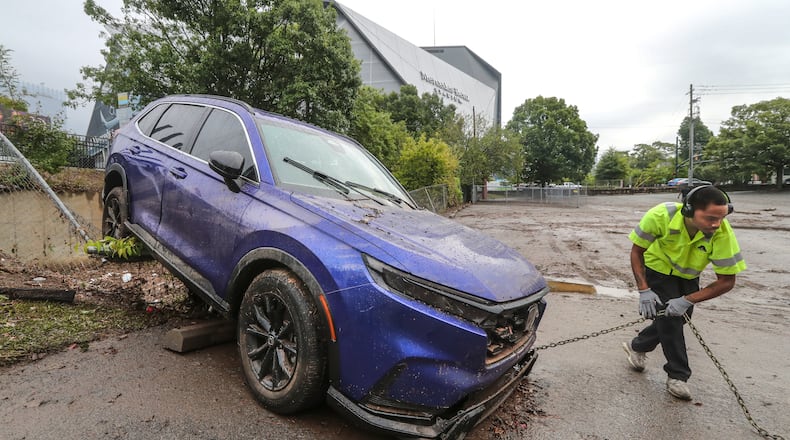Atlanta was cleaning up Friday after a powerful storm drenched the city with nearly 4 inches of rain, flooding downtown streets, turning cars into boats (or submarines) and forcing university students to evacuate their dorms.
Crews cleared fallen trees and towed waterlogged vehicles that swept away when the storm stalled over the area for about 90 minutes Thursday afternoon.
They also cleaned dorm buildings at Clark Atlanta University, where flooding in Holmes Hall ripped apart walls and damaged rooms, displacing about 20 students. One student’s leg was trapped in a doorway in Holmes before she was eventually freed, fellow student Morgan Lee said.
By Friday, classes had resumed and the university had received an overflow of money, food, clothing and other donations for displaced students.
Credit: John Spink/AJC
Credit: John Spink/AJC
Clark Atlanta senior Ashley Harvey had parked her SUV near campus before walking to class Thursday, returning about two hours later to find it under water.
“I don’t know what I’m going to do,” said the fashion design major who bought the car in April. “I’m not sure how I’ll get to class.” Asked if her insurance would cover the damage, she replied, “God, I hope so.”
What happened?
Such storms are not unusual this time of year. But what turned a fairly typical one into a dangerous flood? In short, humans have altered the environment where these storms are happening, according to experts. Global average temperatures have risen by roughly 2 degrees Fahrenheit since 1880. Scientists have known for years that a warmer atmosphere can hold more water vapor, producing storms that can dump more rain in a short period of time.
Some of the worst flooding occurred downtown and south and west of Atlanta’s urban core. Those areas are packed with more concrete, buildings and other impervious surfaces than the rest of the city and have fewer trees and greenspaces that can help absorb runoff. When heavy rain falls on pavement, it can quickly overwhelm stormwater drainage systems, turning roads and creeks into rivers, said Marshall Shepherd, director of the University of Georgia’s Atmospheric Sciences Program.
Data from a water gauge in Proctor Creek northwest of downtown shows water levels rose 10 feet in less than an hour Thursday afternoon. The rate of rainfall was likely made more intense by climate change. Parts of Atlanta may have received 3 inches of rain in an hour, according to preliminary estimates from the National Weather Service. Over the last 30 years, federal data shows, the city has averaged about 3.8 inches for all of September.
Thursday’s storm and others like it show that cities need to prepare for more intense deluges, Shepherd said.
”We saw the same thing in New York after Hurricane Ida,” he said, referencing the 2021 storm that caused deadly floods across the Northeast. “The stormwater design and infrastructure just isn’t prepared for this.”
Getting ready for next time
Water sloshed into the Fulton County Government City atrium on Thursday; Atlanta City Hall wasn’t spared, either.
“Our garage flooded and we were able to get the water out after it receded,” said Mayor Andre Dickens, who spent time Friday speaking with the presidents of Clark Atlanta, Morehouse, Spelman, Morris Brown, Georgia Tech and Georgia State for campus updates.
“Our watershed department said that two to three hours’ worth of rain happened in 15 minute,” Dickens said. “It all receded after the rain stopped. And so the water went on down the sewers, but the damage was done.”
Dickens has asked the city’s Watershed Management Department to evaluate Atlanta’s sewer grid.
“These stormwater events,” he said, “are happening more frequently. Mayor Shirley Franklin did a good job in investing in our sewer network in the past and it may be time to look at some more.”
Not far from City Hall, the Georgia Aquarium and World of Coca-Cola evacuated guests Thursday but resumed normal operations Friday. Nearby, the Rev. Vance P. Ross looked on as tow trucks fished flooded vehicles out of the parking lot at Central United Methodist Church. The church sits in the shadow of Mercedes-Benz Stadium. Ross spent much of the morning on the phone with an insurance company after his congregation’s fellowship hall was flooded. Mud lines on the door indicated at least 4 feet of floodwater.
Outside, a large Dumpster had floated about 50 yards, Ross said, and a blue Honda SUV was washed into a fence and quickly filled with rainwater. Nobody was injured, the pastor said, adding the father and son who were inside the Honda safely escaped.
“Water is life-giving, but it can also be life-taking,” Ross said. “The first step is to clean up and assess the damage.”
Credit: John Spink
Credit: John Spink
Wind gusts from the storm knocked down branches and several trees, including one that landed on a preschool playground in Grant Park. The enormous tree’s root ball ripped up chunks of brick and concrete sidewalk. On its way down, it snapped another tree in half, damaging the roof of a home next door and crushing much of the playground’s equipment. No one was injured.
“It’s such a blessing that it happened at naptime while the kids were all tucked into their cots asleep,” said Candace Dupree, executive director of Grant Park Cooperative Preschool.
Jerome Gaines, who has driven tow trucks for 25 years, said he thought his colleagues were joking when they described some of the damage.
“It’s crazy,” he said, as he hooked a waterlogged sedan to the back of his truck. “The rain didn’t last long — maybe 30 minutes? But I’ve never seen anything this severe.”
Credit: TNS
Credit: TNS
AJC staff writers Riley Bunch, Rosana Hughes and Vanessa McCray contributed to this report.
Keep Reading
The Latest
Featured







